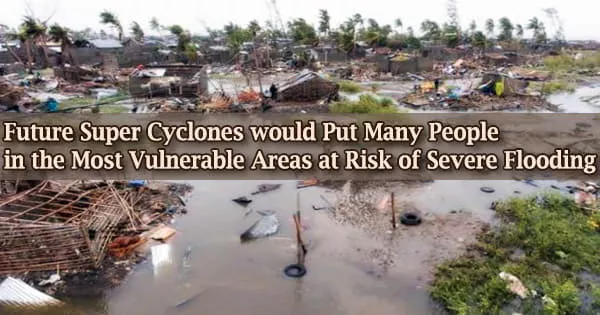According to a new study, super cyclones, the most powerful type of tropical storm, are expected to have a far greater impact on people in South Asia in the coming years.
A super cyclone is a rapidly rotating storm system with a spiral arrangement of thunderstorms, rain, a low-pressure center, and powerful winds. They grow over enormous quantities of warm water and get their energy from the evaporation of water from the ocean’s surface.
When moist air rises and cools to saturation, it condenses into clouds and rain. Tropical cyclones are low-pressure systems that originate over warm tropical waters and have gale force winds near the center (sustained winds of 63 km/h or higher, with gusts exceeding 90 km/h).
The worldwide study, conducted by the University of Bristol, looked at the 2020 Super Cyclone Amphan, which is expected to be the most expensive cyclone to hit South Asia, and estimated its effects in three scenarios of sea level rise due to global warming.
Its findings, which were published today (May 9, 2022) in the Royal Meteorological Society journal Climate Resilience and Sustainability, showed that if greenhouse gas emissions continue at the current rate, more than two-thirds (250 percent) of India’s population would face flooding of greater than one metre, compared to the event in 2020.
The latest IPCC report has mentioned with high confidence that tropical cyclones with higher intense categories will be more frequent in the future. This study shows that population exposure in Bangladesh and India will be increased up to 200% in the future for extreme storm surge flooding (greater than 3 metres) from intense cyclones under high emission scenarios.
Professor Saiful Islam
Lead author Dann Mitchell, Professor of Climate Science at the University of Bristol, said: “South Asia is one of the most climate-sensitive regions in the world, with super cyclones causing tens to hundreds of thousands of deaths in historical cases. Comparatively, very little climate impact research has been done in South Asia, despite the Intergovernmental Panel on Climate Change highlighting it as such a critical region.”
In conjunction with local experts, this project delivers much-needed climate impact data in one of the world’s most vulnerable locations. It provides essential evidence in support of reducing our greenhouse gas emissions in order to meet the Paris Agreement climate targets, as other lines of research all too often focus on high-income countries with smaller consequences and easier adaptation.
The researchers, who included Bangladeshi experts, utilized advanced climate model forecasts to estimate the number of people who may be affected by cyclones in the next decades.
Although the increase in the number of people at danger in Bangladesh is expected to be less dramatic, with estimates ranging from 60% to 70%, this will result in decreased coastal populations in the future.
In coastal places, extreme flooding can occur when storm surge coincides with normal high tide, resulting in storm tides of up to 20 feet or more in some situations. Storm surge is generally the greatest threat to life and property along the coast from hurricanes.
The research team went on to show that if the Paris Agreement climate goals of 2 degrees Celsius over pre-industrial levels are met, population vulnerability to flooding will reduce to near nil.
However, even in this climate-change scenario, India’s exposures revealed an alarming growth of between 50% and 80% of the country’s exposures are predicted to experience flooding in the future.
The Paris Agreement, a global framework to combat climate change, aims to keep global average temperature increases well below 2 degrees Celsius above pre-industrial levels, with a goal of 1.5 degrees Celsius.
Professor of Hydrology at Bangladesh University of Engineering and Technology (BUET) and co-author of the work, Saiful Islam, said:
“The latest IPCC report has mentioned with high confidence that tropical cyclones with higher intense categories will be more frequent in the future. This study shows that population exposure in Bangladesh and India will be increased up to 200% in the future for extreme storm surge flooding (greater than 3 metres) from intense cyclones under high emission scenarios.”
“Hence, a strong, rapid and sustained greenhouse gas reduction is essential to achieve goals of the Paris Agreement and to reduce losses and damages of highly vulnerable countries like Bangladesh.”
















